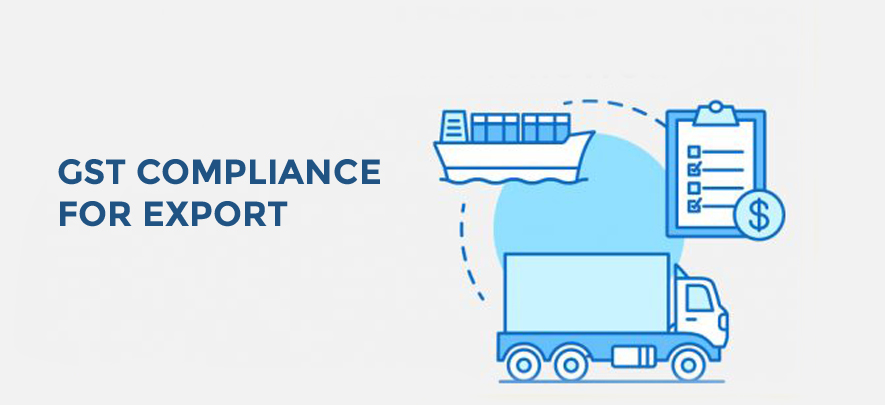GST compliance to be followed during export

இறக்குமதி மற்றும் ஏற்றுமதி
265 வாரத்திற்கு முன்பு — 5 நிமிடம் படிக்க
Background: GST (Goods and Services Tax) is applicable only on those goods and services whose consumption is done within India and hence goods exported should not be taxed. Even the general principle on which the tax law works is that tax should not be exported. However, to claim a refund on the export made, one should be a registered person under GST. Vakilsearch in this article explains the GST compliances for exports.
GST goods exported are considered to be a zero-rated supply. Zero-rate supply means a tax-free supply of either goods or services and the person exporting the goods will be able to claim a refund of the amount of tax paid while exporting. For the export of services, it is important that the payment is received in convertible foreign exchange to treat such supply of services as an export.
Under the IGST Act, the export of goods means taking of goods out of India to a place outside India and covers supply made to SEZ units. However, to claim a refund on the export made, the person should be a registered person under GST. The refund can be claimed or availed through two means:
- The person exporting can either do so under a bond or by submitting a letter of undertaking without the payment of Integrated tax and s/he may claim a refund of the unutilised ITC (Input tax Credit)
- S/he can export goods or services or both by paying the integrated tax and then claim the amount of tax paid.
Documents required while claiming the refund
- A copy of the invoice
- Copy of returns to prove the payment of duty
- Documents for proving that the burden of tax payment has not passed
- Any other relevant document
Refund procedure
In case of the zero-rates supplies, the person concerned is not required to file a separate refund application (GST-RFD-1) as the shipping bill that the exporter files act as a refund claim in itself. For the purpose of treating shipping bill as a refund application two conditions need to be satisfied:
- An export manifesto to be filed by the person carrying the goods.
- The person claiming a refund should have filed return GSTR-3 and GSTR-3B correctly.
On complying with the above conditions, the department will process the refund.
Also read: Import Export Code (IEC): Benefits and how to obtain it
Mandatory requirement and steps to be followed during export
- GSTIN should mandatorily be mentioned on the shipping bill where the goods exported attracts GST for domestic clearance.
- When the export is done by the specialized agencies then the exporter instead of GSTIN can mention Unique Identity Number on the shipping bill.
- For goods wholly exempted under the GST regime or outside the purview of GST, in such cases mention PAN (Import Export Code).
- Shipping bill would not be admissible in case the person fails to mention GSTIN/UIN/PAN.
- When there are multiple tax invoices on the same GSTIN number, then in such cases the invoice will be allowed on one shipping bill for the same consignee.
- Further, the refund of IGST or ITC on the inputs that were consumed on the goods exported would not be processed without a GSTIN and GST invoice details on the shipping bill.
- In case there is a commercial invoice, it should be mentioned in the shipping bill and where a commercial invoice and a tax invoice is different, both will be separately mentioned on the shipping bill.
- For the refund, taxable value and the amount of tax should be mentioned in the bill against each item.
- On the column of State of Origin, write the code of the State from where the export goods originate.
- GST RFD-11 is to be filed where goods are exported without the payment of IGST.
(Rule 96A of the Central Goods and Services Tax Rules, 2017)
- For a person who is a status holder or has received convertible foreign exchange at 10% of the turnover or a minimum of INR 1 crore in the last financial year and has not contravened the provision of law can instead of bond submit LUT (Letter of Undertaking).
- In case, where the bond is filed:
- It should be on a stamp paper (non-judicial). Value of the stamp paper will depend on the state it is furnished. Bank guarantee of not more than 15% of the tax involved.
- Bond should mention the amount of tax liability of the exporter which would an estimated amount that the exporter would have calculated.
Where the conditions of export have not been complied by the exporter, s/he would be liable for consequential interest and tax and the LUT or Bond would then become in-operative and would be operative on fulfilling the required procedure.
Also read: Exporters can make additional profits with this incentive scheme
To explore business opportunities, link with us by clicking on the 'Connect' button on our eBiz Card.
Disclaimer: The views and opinions expressed in this article are those of the author and do not necessarily reflect the views, official policy or position of GlobalLinker.
பதிவிட்டவர்
Vakilsearch StaffGreetings! We would love to work with you and your company. We look forward to connecting with business houses and MSME's.
இந்த கட்டுரையில் குறிப்பிட்டுள்ள SME களுடன் பிணையம்
Vakilsearch இன் சுயவிவரத்தை காண்க
SME இன்ஸ்பிரேஷன்ஸ்
Vakilsearch Staff எழுதப்பட்ட பிற கட்டுரைகள்
What Is the Difference Between Corporation and Incorporation?
23 வாரத்திற்கு முன்பு
Difference Between Stock Market and Commodity Market
56 வாரத்திற்கு முன்பு
What is the Difference Between Labour and Employment Law?
110 வாரத்திற்கு முன்பு
இந்த வாரம் அதிகம் படித்தது
டிரெண்டிங்
Declutter Your Business the Marie Kondo Way
Health & Lifestyle 27 வாரத்திற்கு முன்பு
How to Process and Ship Orders on Your Linker.store
Ecommerce 116 வாரத்திற்கு முன்பு
Get more sales leads with an online business profile
GlobalLinker Assist 130 வாரத்திற்கு முன்பு
















கருத்துகள் (1)
தயவு செய்து உள்நுழைய அல்லது பதிவு விவாதத்தில் சேர